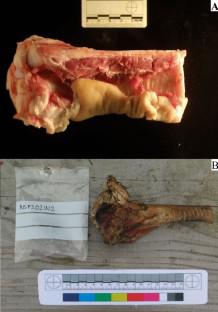Journal of Archaeological Method and Theory ( IF 3.073 ) Pub Date : 2023-08-15 , DOI: 10.1007/s10816-023-09615-8 Emese I. Végh , Nicholas Márquez-Grant , Rick J. Schulting

|
Major complications in the palaeopathological analysis of burnt human remains include distinguishing whether bone was fresh or dry at the time of burning, and whether trauma/damage was inflicted ‘perimortem’ or postmortem. Some prehistoric societies are suggested to have defleshed human remains prior to cremation, mostly classified based on the lack of warping and thumbnail fractures. The distinction between perimortem and postmortem sharp force trauma (SFT) characteristics has rarely been investigated on burnt bones. This study investigates whether these features are distinguishable on burnt bone, as well as assessing the rate of cutmark survival, and the presence of heat-induced fractures in relation to the bone’s pre-burnt collagen content. Pig (Sus scrofa domesticus) tibiae were left to decay in a field for 14, 34, 91, 180, and 365 days in Wytham Woods, Oxfordshire, UK. Prior to burning, bones were inflicted with SFT by a non-serrated and partially serrated knife and a flint blade (N = 15/bone). Fleshed bones with cutmarks and bones without trauma served as controls. Cutmark survival, features, and heat-induced fractures were recorded on the burnt bones and compared with the collagen extracted from unburnt bones at the abovementioned time intervals. Statistical analysis included linear regression and MANOVA. Heat-induced fractures did not depend on the limited collagen loss during the 1-year postmortem inverval (PMI) prior to burning. There was a loss (mean 18.4%) of identifiable cutmarks after burning. Significant alterations in the cutmark characteristics appeared after 6 months of exposure in burnt bones, marked by the increase in postmortem features, which can inform on the pre-burning PMI.
中文翻译:

锐力损伤死后时间和烧骨预烧条件的确定
对烧焦的人类遗骸进行古病理学分析的主要并发症包括区分烧伤时骨头是新鲜的还是干燥的,以及创伤/损伤是在“死前”还是“死后”造成的。有人认为,一些史前社会在火葬前已经将人类遗骸剔除肉质,大部分是根据没有变形和拇指指甲骨折来分类的。生前和死后锐力创伤 (SFT) 特征之间的区别很少针对烧伤的骨头进行研究。这项研究调查了这些特征在烧焦的骨头上是否可区分,并评估了切割痕的存活率,以及与骨头烧焦前的胶原蛋白含量相关的热致骨折的存在。猪(野猪))胫骨在英国牛津郡威瑟姆森林的田地里腐烂了 14、34、91、180 和 365 天。在燃烧之前,用无锯齿刀和部分锯齿刀和燧石刀片对骨头进行 SFT(N= 15/骨)。有割痕的肉骨和没有创伤的骨头作为对照。记录烧焦骨头上的切割痕迹存活率、特征和热致骨折,并与在上述时间间隔从未烧焦骨头中提取的胶原蛋白进行比较。统计分析包括线性回归和多元方差分析。热引起的骨折并不依赖于烧伤前一年死后反转(PMI)期间有限的胶原蛋白损失。燃烧后可识别的切割痕迹损失(平均 18.4%)。暴露在烧焦的骨头中 6 个月后,切割痕迹特征出现显着变化,其标志是死后特征的增加,这可以为燃烧前的 PMI 提供信息。



























 京公网安备 11010802027423号
京公网安备 11010802027423号